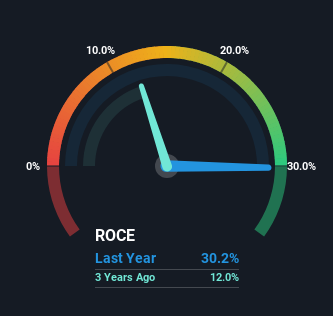- United States
- /
- Semiconductors
- /
- NYSE:DQ
Why The 30% Return On Capital At Daqo New Energy (NYSE:DQ) Should Have Your Attention
There are a few key trends to look for if we want to identify the next multi-bagger. In a perfect world, we'd like to see a company investing more capital into its business and ideally the returns earned from that capital are also increasing. Ultimately, this demonstrates that it's a business that is reinvesting profits at increasing rates of return. With that in mind, the ROCE of Daqo New Energy (NYSE:DQ) looks great, so lets see what the trend can tell us.
What Is Return On Capital Employed (ROCE)?
Just to clarify if you're unsure, ROCE is a metric for evaluating how much pre-tax income (in percentage terms) a company earns on the capital invested in its business. To calculate this metric for Daqo New Energy, this is the formula:
Return on Capital Employed = Earnings Before Interest and Tax (EBIT) ÷ (Total Assets - Current Liabilities)
0.30 = US$2.0b ÷ (US$7.3b - US$713m) (Based on the trailing twelve months to June 2023).
Therefore, Daqo New Energy has an ROCE of 30%. That's a fantastic return and not only that, it outpaces the average of 12% earned by companies in a similar industry.
See our latest analysis for Daqo New Energy

Above you can see how the current ROCE for Daqo New Energy compares to its prior returns on capital, but there's only so much you can tell from the past. If you'd like to see what analysts are forecasting going forward, you should check out our free report for Daqo New Energy.
How Are Returns Trending?
Daqo New Energy is displaying some positive trends. The data shows that returns on capital have increased substantially over the last five years to 30%. The company is effectively making more money per dollar of capital used, and it's worth noting that the amount of capital has increased too, by 885%. The increasing returns on a growing amount of capital is common amongst multi-baggers and that's why we're impressed.
In another part of our analysis, we noticed that the company's ratio of current liabilities to total assets decreased to 9.7%, which broadly means the business is relying less on its suppliers or short-term creditors to fund its operations. So this improvement in ROCE has come from the business' underlying economics, which is great to see.
In Conclusion...
In summary, it's great to see that Daqo New Energy can compound returns by consistently reinvesting capital at increasing rates of return, because these are some of the key ingredients of those highly sought after multi-baggers. Since the stock has returned a staggering 448% to shareholders over the last five years, it looks like investors are recognizing these changes. In light of that, we think it's worth looking further into this stock because if Daqo New Energy can keep these trends up, it could have a bright future ahead.
Daqo New Energy does come with some risks though, we found 3 warning signs in our investment analysis, and 1 of those doesn't sit too well with us...
High returns are a key ingredient to strong performance, so check out our free list ofstocks earning high returns on equity with solid balance sheets.
New: Manage All Your Stock Portfolios in One Place
We've created the ultimate portfolio companion for stock investors, and it's free.
• Connect an unlimited number of Portfolios and see your total in one currency
• Be alerted to new Warning Signs or Risks via email or mobile
• Track the Fair Value of your stocks
Have feedback on this article? Concerned about the content? Get in touch with us directly. Alternatively, email editorial-team (at) simplywallst.com.
This article by Simply Wall St is general in nature. We provide commentary based on historical data and analyst forecasts only using an unbiased methodology and our articles are not intended to be financial advice. It does not constitute a recommendation to buy or sell any stock, and does not take account of your objectives, or your financial situation. We aim to bring you long-term focused analysis driven by fundamental data. Note that our analysis may not factor in the latest price-sensitive company announcements or qualitative material. Simply Wall St has no position in any stocks mentioned.
About NYSE:DQ
Daqo New Energy
Manufactures and sells polysilicon to photovoltaic product manufacturers in the People’s Republic of China.
Flawless balance sheet with high growth potential.
Similar Companies
Market Insights
Community Narratives



